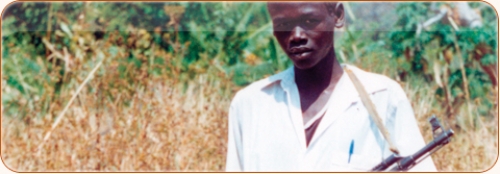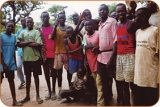Decades of civil war—and now genocide in Darfur—have driven thousands of Sudanese people from their homes. Refugees, unsure of their safety and fearful about what the future has in store, have made do in other, less war-torn parts of Sudan and in neighboring Kenya, Uganda, and Chad. Now that a peace agreement is on the table, will the people come home?
Strong ties
With so many Sudanese displaced or dead, there may not be much reason for refugees to make the treacherous journey back to their villages. “The flight from home is extremely traumatic,” says Kavita Singh, a research assistant professor in UNC’s Maternal and Child Health Department and research associate for the MEASURE (Monitoring and Evaluation to Assess and Use Results) Evaluation project. “People are moving with basically nothing. They’re walking hundreds of miles. South Sudan has such a harsh climate. In the hot season, it’s incredibly hot and dry, and there’s very little water. And in the rainy season, it’s hard to move—the rain floods everything. There’s very high mortality during the actual migration, because people are moving without food or water.”
And the trip can be especially harrowing for children and the elderly, who are more vulnerable to malnutrition and infectious diseases.
The return home can be traumatic, but the longing for home is powerful. And if the move is organized and humanitarian organizations are involved, it generally goes more smoothly than the initial journey.
Singh is confident that people eventually will go back, even if their houses are no longer standing.
“I think it will take time,” she says. “Some of the better-off families who migrated to Uganda or Kenya may have their children in some very good schools, and would be more hesitant to go back. But slowly, people will go.”
Given the trip’s difficulty, people will first want to hear from their relatives and friends that the basics are covered: that schools and health facilities are available, and that they can live in their villages without fear of bombing. “Because of the war, the infrastructure of the country hasn’t developed or it’s been destroyed,” says Singh, who worked in south Sudan training community health workers and did her graduate study with populations displaced by forced migration. The schools and hospitals that exist in south Sudan, for example, have often been targeted and bombed.
When refugees do come back, they may have to rebuild more than their homes. Over time, many Sudanese towns and villages have become bereft of young men, who have left to become soldiers, been killed, or been kidnapped, Singh says. But now that the war has officially ended, the survivors among these men will start to return, and communities will eventually normalize.
Now that an official peace agreement has been enacted, refugees in neighboring countries may also face pressure from those governments to return to Sudan.
Darfur
The Darfur region, a land of harsh, sandy winds and fierce desert sun, lies in the west along Sudan’s border with Chad. Since 2003, Darfur has been the site of government-sponsored genocide of black Africans by Arab militias (called Janjaweed). The violence began when black tribes in the west, their interests long neglected by the mostly Arab government in Khartoum, took arms to voice their grievances at being left out of negotiations for the Comprehensive Peace Agreement (CPA).
Unwilling to relinquish any share of government power, the Janjaweed destroyed villages throughout Darfur, raping and killing along the way. Though Khartoum officially claims that the government opposes the militias, the Janjaweed’s arms and money are federally supplied.
Despite the fact that the massacre in Rwanda was only a decade ago, no one has come to Sudan’s rescue. And it’s too late now to do much, says Andrew Reynolds, political science professor at UNC and advisor to the Southern Sudanese during last year’s peace talks. “The conflict has effectively burned itself out,” he says. “Khartoum has won. There are few people left to rape or murder and no villages left to raze—everyone is either displaced elsewhere in Sudan, in Chad, or dead.”
Another try at peace
In January 2005, Sudan signed the CPA. The pact arranged for power to be shared between the country’s main factions: the north’s National Congress Party and the south’s Sudan People’s Liberation Movement, along with a small handful of other political groups.
Civil conflict is nothing new for Sudan, and neither is the signing of a peace agreement. The country has struggled with war for decades, Reynolds says. Historically, the greatest conflict has been between northern and southern Sudan, a perpetual violence over differences in religion, ethnicity, and access to natural resources.
Northern Sudan, mostly Muslim and Arab, lacks the natural resources of the primarily Christian, black African south, including oil, fertile agricultural land, minerals, and water. But thanks to a fifty-year legacy of powerful Islamic military regimes, the north has dominated the country’s government and wealth.
So while the enactment of the CPA is a positive and important step, it alone will not be effective, Reynolds says. Because of the intensity of the power struggle between north and south, and the length of time the two forces have been at war, both groups are reluctant to cede even a fraction of power to any other group—including tribes fighting for a voice in Darfur.
But Susan Stigant, of the UNC-Duke Rotary Peace Studies Program, remains hopeful. She’s currently working in southern Sudan with the National Democratic Institute (NDI) for International Affairs. Her goal is to allow ordinary citizens to communicate with political leaders. In effect, she’s working for peace from the ground up.
One of the crucial steps on the bumpy road to democracy—particularly in a war-ravaged place such as Sudan, with a scattered and unstable population—is getting the message out to the people about what’s going on with the government, Reynolds says. And that’s where Stigant comes in. Every six months, she recruits and trains teams of Sudanese moderators and goes with them to local communities to gauge public opinion and awareness about the country’s political developments.
Turning ears toward democracy
Stigant’s group is also working with Sudan Radio Service to produce a civic education program that will be aired a few times a week. Citizens will be able to tune in to discussions about the new constitution and bill of rights, gender equity, the fighting of corruption, and the census, and learn how democracy works in general.
Many Sudanese have radios, but for those who don’t, Stigant and the NDI are stepping in. To ensure that people can access the program, Stigant’s group is distributing approximately forty thousand hand-crank and solar-powered radios.
Radios can reach the highest number of people, but face-to-face interaction is still essential for effective civic education, Stigant says. To this end, the NDI will hold listening groups in six main locations to bring people together to hear and discuss the radio program. The plan is to record segments of these discussions and integrate them into future radio programs. This will give people a chance to hear diverse voices from throughout the country—Arabs will hear blacks’ views, southerners will hear northerners’ views. In a country as vast and divided as Sudan, crossing these boundaries is a big deal.
“Ultimately, we also hope to take some of people’s questions to government officials and allow them to respond on the radio program,” Stigant says. “Lack of information is a serious problem here, and we hope that by providing this information, we’re preparing people to begin participating in political processes. It’s a step-by-step process, and will take time.”
A people’s future
Will the peace agreement hold? That’s the million-dollar question. “The systems of governance are there on paper, but they are proving difficult in the implementation,” Stigant says. “My sense is that Sudan is going to be an elastic band of democracy. There are going to be a lot of forces trying to stretch it to its capacity to get the most possible for their own personal gain.”
Singh is more optimistic. “There might be breaches, but I think the peace agreement will hold overall—at least until 2011, when they’ll have a referendum on whether the south wants to remain part of Sudan or whether it wants its own sovereignty,” she predicts.
Despite the lack of access to education and resources, most Sudanese are eager to learn and work toward a brighter future, Singh says, and this will work in their favor as the country begins rebuilding itself. “People would come to our training centers asking, ‘What’s next?’ You often find young people saying they want to get an education so they can help their people, which is really inspiring. They have a commitment to making things better in their country,” she says.
“My Sudanese counterparts are a dedicated group with incredible vision and unwavering commitment to implement that vision,” Stigant says. “The struggle for democracy and stability in Sudan has only begun. I have to believe in the possibility of change, or I wouldn’t be here and I wouldn’t get out of bed every day.”






